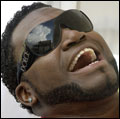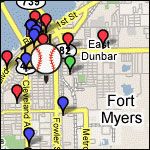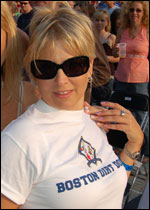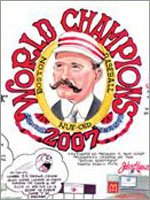Umpire State
Tom's Trip to the Show
Tom Verducci's column in the April 2 Sports Illustrated (republished with SI's permission)

Two Springs after his cameo as a Blue Jays outfielder, SI’s Tom Verducci was back in the bigs, this time as an umpire for an Red Sox-Orioles game. All he had to be was perfect. (And what manager, player or fan would even believe that?)
Embarrassment.
Injury. Blunt force trauma.
Estate planning. The mind quickly accelerates the possibility and the amplitude of catastrophe when you are standing on the infield grass, as I am, 75 feet in front of Boston Red Sox slugger Manny Ramirez while he bats with a runner on first base. No infielder ever would be so foolish to put himself this close to the potential harm of a Ramirez line drive, not even armed with world-class hand-eye coordination, a fielder’s glove and a protective cup—all of which, as I am most acutely aware, I do not possess at this moment.
I am a major league umpire—for one day anyway, March 23, working a spring training matinee between the Red Sox and the Baltimore Orioles in Fort Myers, Fla. Leaving the observational safety of sportswriting, I have been granted permission by Major League Baseball to experience the pressure, the difficulty and the thanklessness of risking life, limb and public humiliation in front of thousands of people conditioned to dislike you. I am assigned the same spring rotation as my full-time brethren:three innings at third base, followed by three at second and three at first.
The baseball we hold dear is a benign, leisurely sport, a “noncontact” pursuit in which we cherish its sweetly proportioned empty spaces. The interlude between pitches. The flanks in the alignment of fielders. The 90 feet between bases. The flight of a thrown or batted baseball offers elegant interruption to the spatial symmetry.
Working from the interior of the infield, however, reveals the power and speed of the game. It’s the difference between observing a funnel cloud from a safe distance on the ground and flying a research plane into the vortex of a tornado. “I tell all the young umpires that come up from the minors, ‘Expect a close play every time,’” says Tim Tschida, 46, my crew chief who is working home plate this game. “[The play’s] only routine here after it’s over. That ball three steps to the right of the shortstop? They don’t get to that ball in the minors and here they might throw the guy out. Middle infielders get to more balls up the middle that minor leaguers would never get to—and not only get to them, but turn them into double plays. I tell the young guys, ‘Don’t give up on anything.’”
My proximity to Ramirez, who is poised in that familiar asplike, coiled stance, is gripping, but the responsibilities of the job rattle around in my head, like marbles tumbling in a dryer. I’ve got to keep watch on the Orioles’ pitcher, Erik Bedard, for a possible balk, the Sasquatch of rules violations for its difficulty to observe. (I’ve already missed one by Boston starter Curt Schilling, but so, too, did the rest of the crew.) I must make all calls at second base, which is over my right shoulder (including a stolen base attempt or a force play, which is the most commonly missed call by umpires), and possibly at third base if the umpire there, Brian O’Nora, leaves his post to track a ball hit to the outfield.
I must also know the rule book and the grounds rules with absolute certainty, a weakness of mine exposed during a mild argument the previous half inning with Boston rightfielder J.D. Drew (who had no clue he was pleading his case to a sportswriter until I told him the next day). And one more thought—the mother of all marbles. Being an umpire is like being a jet pilot, a skydiver or a sword swallower: You’re expected to be perfect every time, and if you do screw up it’s obvious to everyone. Nothing less than flawless is acceptable. I must get it right.
“God knows if you don’t have the mental aptitude for this, you’d ask, ‘What are you doing?’” says Fieldin Culbreth, another crew member. “If you’re right, nobody’s coming in and patting you on the back. If there are 10 close plays and you get 10 exactly right, they’re booing you anyway. The only people who will say, ‘Good job’ are the other three guys in the [locker] room with you. The teams aren’t going to say, ‘Hell of a job.’ ESPN’s not going to say, ‘Watch this umpire!’ Here’s the difference: The players are trying to make a play to get on SportsCenter. We’re trying our damnedest to stay off it.”
I trained long (O.K., two days with Tschida and Culbreth) and hard (kicking back watching games in the Florida sun) for this gig. Ominously, the most important advice given to me by the umpires was to avoid utter disaster. My Umpire 101 syllabus looked like this:
1. Don’t blow out the knee of Baltimore shortstop Miguel Tejada by watching the flight of a pop-up near the third base line.
The fielder, who is also looking up, is likely to plow into the umpire, whose proper course of action is to first look for and avoid the fielders. “You getting hurt is one thing,” Culbreth says. “The player getting hurt? Now there’s a problem.”
2. Beware of balls that explode.
That’s umpire terminology for what happens when you try to track a ball as it passes directly over your head, causing you to lose sight of it.
3. Don’t chase down a batted or thrown ball; that’s the players’ job.
Don’t laugh; it’s happened. Former major leaguer Ron LeFlore flunked umpire school in 1988 for his instinctive reaction to play the ball like the outfielder he once was rather than getting into proper position.
4. Don’t get spun around by line drives hit directly at you; you’ll fall on your butt or, worse, get pegged there.
Culbreth recalls the time that no sooner had he remarked that he had never seen Jeromy Burnitz hit a line drive than Burnitz nailed first base umpire Terry Craft in the posterior. “It went up one side of his [butt] and down the other,” Culbreth says.
5. Make sure your fly is zipped.
Basically, the job comes down to this: If I can quit worrying long enough about wiping out Tejada, about baseballs that either explode, tempt me to field them or put me on my can, and about keeping my pants on properly, then all I need to do is nail every single call. Great.
“Umpiring is a gift,” says ump Tim Timmons, 39, who also assisted in my training, “like the hitter who has the skill to hit that 90-mph slider or the pitcher who can do things with a baseball no human being should be able to do. Those are real gifts, and so is umpiring. You can’t teach instincts.”
Major league umpires are, in fact, closer to perfect than you might imagine. There were 167,341 at bats last season over 2,429 games. According to the 2006 “Umpiring Year in Review,” a report put together by MLB officials, the men in blue made only 100 incorrect calls, excluding balls and strikes (and in that discipline they were judged to be 94.9% accurate). Not once did a club protest a game. (A protest can be filed only if a team believes umpires misapplied the rules.)
For the privilege of having to be perfect, umpires spend about 200 days a year on the road, hear the same lousy jokes in every ballpark about their eyesight or familial heritage, and routinely get second-guessed by critics watching repeated superslow, frame-by-frame replays in high definition from multiple camera angles. Yet major league umpiring jobs (of which there are 68) open up these days about as infrequently as those on the Supreme Court. What kind of person would love a job in which you get noticed only for your mistakes?
“I’ve always said there’s no player, no fan, no manager and no umpire who could ever be as hard on me as I’ll be,” says Culbreth. “The fans can boo and throw stuff, and managers can scream and holler and get ejected, and they’ll never get to me like I will. The part that bothers me the most is people think we miss a call, change our clothes, get in a station wagon, go have a cheeseburger and go home. That’s just not how it is. If people knew how much we cared ... they wouldn’t be able to comprehend how much it bothers us to find out that we are wrong.”
“You’re expected to be perfect the day you start, and then improve.”
—Ed Vargo, NL umpire supervisor, 1985
Schilling and Bedard are throwing so well that my three innings at third base pass without incident. The best action I get is a conversation with Boston third baseman Mike Lowell about April weather, and a Manny-being-Manny moment when, as Ramirez runs to leftfield, he looks at me with wild-eyed glee and chortles, “Heeeey! Que pasa?!” I get no appeal calls on check swings by lefthanded batters, an especially tricky call for umpires because the rule book is not explicit about what exactly constitutes a swing.
Says Culbreth, laughing, “Just remember, if it’s David Ortiz, he didn’t [swing]. Trust me. After you say he did, he’ll tell you. He’ll faint. If I could hit with his check swings I might have gotten drafted.”
According to Major League Baseball’s review, in 2006 umpires missed a call in the field only once every 12.2 games. Force plays (43 mistakes), tag plays (14) and steals (12) were the only categories in which umpires missed 10 or more calls the entire season. Video replay, however, is just around baseball’s corner, at least in a limited scope. Baseball is studying the possibility of using it to assist in making home run calls—fair or foul, and whether or not the ball cleared the wall or designated home run line. Such calls have been made more difficult by modern ballpark designs, which put fans, architectural elements and billboards closer to the action.
“If we don’t address this, there will be a major controversy and that’s how replay gets in the door,” Tschida says. “Last year our crew in the first month had five home run calls where we had to get together [to discuss them]. I was thinking, Are we snakebit? So I started keeping track. We had 43 home runs where the ball came back on the field. It’s not supposed to happen, but it happens when nonbaseball people are designing fields.”
I have the pleasure of calling a clean, no-doubt home run by Red Sox catcher Jason Varitek in the fifth, but it’s during those middle innings, when I am stationed at second base, that the inner game of umpiring becomes dangerous. The second base umpire is the lead dancer of the four-man ballet. I must run into the outfield on balls hit from gap to gap with nobody on base, with the third base umpire rotating to second and the home plate ump rotating to third. “Once you leave, don’t stop,” Culbreth instructs.
However, in the fourth, I am positioned in the interior infield because there’s a runner at first base—“Once in, always in” is the rule with runners on—and I make the mistake of chasing a ball hit into the right centerfield gap by the Orioles’ Jay Gibbons. It’s a blunder most fans would never notice, but understanding the umpires’ pursuit of perfection, it rankles me. Indeed, I’m later told that umpire supervisor Marty Springstead, watching the game from the press box, exclaimed, “Uh-oh, too many umpires in the outfield.”
The next batter, Kevin Millar, also drives a double into the same gap. The ball rolls to a stop at the bottom of the fence and is returned to the infield by centerfielder Wily Mo Peńa. That play will prompt Drew, after the inning ends, to stop next to me on his way to the dugout.
Drew lifts his arms out to his sides and says to me, “Hey, what’s the rule on the ball that wedges under the fence?”
I can tell he’s very serious and mistakes me for an actual umpire. This is not good.
“Uh, did it go under the fence at all?” I ask in an attempt to avoid his question. “Because if it goes under the fence it’s a dead ball even if he fishes it out.”
“No,” Drew says, more impassioned this time. “The ball got stuck between the bottom of the fence and the ground. What’s the ruling?”
“The ball’s in play unless it goes completely under the fence,” I reply, in full filibuster mode as I return to the under-the-fence diversion.
“No, not under the fence,” Drew says again, more confused than annoyed about not getting a direct answer from an umpire. “What’s the ground rule here on a ball stuck under the fence?”
I’ve tap-danced long enough for Culbreth to rescue me as he joins us from his station at first base. I haven’t been this happy to see an umpire since Leslie Nielsen in The Naked Gun. Culbreth explains that the ball’s in play as long as Peńa chooses to play it; if the ball’s wedged, Peńa can raise his hand to signal a stuck ball. Then the ruling is an automatic double and two bases to any base runner.
“Yeah,” I say to Drew, suddenly summoning an authoritative tone with a straight face. “Tell him next time to just raise his hand and we’ll stop the play.”
I made sure to find Drew the next morning at a Red Sox workout.
“That was you?” he says in amazement. “I came back into the dugout after that and looked at the list [of umpires]. I knew the other three guys, but they didn’t have you on it. So I figured you were some Double A umpire they called up to replace somebody.”
There’s more trouble in the fifth, the same kind of trouble, like the undertow of the ocean, that mostly goes unseen. Baltimore’s Corey Patterson whistles a line drive at Culbreth, the kind of missile that can put an umpire embarrassingly on his butt or whack him there.
Any hitter will tell you that late-breaking pitches are hardest to hit because it is impossible for the eyes to track a thrown ball and see it the last four or five feet. Culbreth is challenged by the same limitation. He can track the ball—it’s heading right for his ankles—but because of its speed and proximity to his body he can’t see it just as it hits the ground. He’s got to make a call. Quickly.
“Fair ball!” he shouts, and signals so, deftly staying off his butt. Patterson races into second with a double as the runner at first, Paul Bako, advances to third.
Schilling pitches out of the jam, but only after he gets away with his covert balk. Stepping off the mound to get a new signal from Varitek, Schilling, a righthander, moved his left foot slightly back, which technically begins his delivery. Tschida sees something amiss, but in the moment he processes the information, he grants a request for time from Varitek. (“Oh, I balked,” Schilling will say the next day.)
After the inning, Culbreth still is thinking about Patterson’s line drive. “That one I don’t feel great about,” he tells me. (Amazingly, according to the MLB report, umpires missed a total of three fair-foul calls all of last season.) “I think I got it right, but sometimes you feel less than great about it.”
“I thought you had it right,” I tell him. “Was there chalk?”
“No, it didn’t hit chalk,” he says, “but here’s the thing: If you ever have some doubt in your mind, you’re better off calling it fair than foul. That’s because, if another umpire had a better look and comes in and says, ‘No, I had it foul,’ then you can just return the base runner and the batter continues to hit. But once you call it foul, everybody stops; so if another umpire has it fair, what can you do? You can’t just make up where everybody goes.”
“You had it right,” I tell him.
Says Schilling, “It was foul by three or four feet. Wasn’t even close.”
“We’re looking right down the line from the dugout,” reliever Mike Timlin says. “It was foul.”
Culbreth gets another adventure straight out of the Umpiring 101 syllabus: a foul pop-up into a swirling wind that confuses Millar, the Orioles’ first baseman. Culbreth is trying to stay out of the way of Millar, who is circling wildly, as if dizzy. Culbreth is doing his best to zig whenever Millar zags. It’s a comedic and ungraceful pas de deux, the punch line coming when the ball plops on the warning track closer to Culbreth than to Millar. Second baseman Brian Roberts looks at me and we both are laughing. So, too, is Tejada, who yells, “Hey, Kevin, I can’t wait to see that on bloopers!” Millar, who otherwise spends his time at first base yelling mock insults to his former Red Sox teammates as they hit, or trying to bait me into making appeal calls from second base on ridiculously meager check swings, has to laugh himself.
“I occasionally get birthday cards from fans. But it’s often the same message: They hope it’s my last.”
—Al Forman, NL umpire, 1961
Here it comes: a close call I will have to make at first base that will impact the game. Boston, trailing 2–1, has runners at first and second with no outs in the seventh when Lowell hits a grounder to second base. Baltimore will try to turn a double play, so I position myself for the call. The throw from Tejada to Millar bounces into the first baseman’s glove. It’s a close play, but I have Lowell out, the bang of the ball hitting the glove barely preceding the bang of the foot upon the bag. (The umpires’ adage is that a blind man could umpire at first base.) The rally is virtually snuffed by the call. Suddenly there’s this swell of noise from the Red Sox crowd, a strange mix of excitement and apoplexy.
Is it directed at Lowell? At me? I thought I had it right, but for one anxious moment, I’m not sure. Did I blow it that badly? No, wait. I flush the doubt. Lowell was out. I’m pretty sure of it. That plaintive groan is the sound of disappointed partisanship. Major league umps are tone deaf to such noise.
“They’re biased,” Culbreth says of fans. “The only time you might hear something is if it’s really original, which almost never happens. I still remember one time when I was in Double A. There was this middle-aged lady. She must have been in her 50s, pushing 60. She gets up and she yells at me, ‘Why don’t you pull down your pants, bend over and try your good eye.’ Nothing’s original. But that was.”
Says Tschida, “There was one time years ago when I bought a patent leather belt and thought it looked just great. Well, I wear it in Yankee Stadium for the first time, and those people know how to wait so that you can hear them. This one guy, a real New Yorker, gets up and yells, ‘Hey, Tschida. How can you make a call like dat wearin’ a patent leathah belt like dat? And hey, what accessories came with dat?’ As soon as the game was over, I go in the locker room, rip off the belt and throw it in the garbage.”
Boston ties the game in the last of the eighth. It is only spring training, but I’m struck by the buzz in the crowd, the effort by both teams to win the game—to preserve the tie, Baltimore intentionally walks Ortiz, who spits epithets all the way to first—and it hits me smack in the gut: I am umpiring first base in a game in which the Red Sox and the Orioles are tied at 2 headed to the ninth. Good Lord, if this is Fort Myers, what must the late innings of a World Series game feel like?
The real umpires want the responsibility of the big call. It’s what drove them through one of the two feeder umpire schools to professional baseball (94% of the students don’t even graduate to the next step, a recommendation to an evaluation course), through the minor leagues (earning between $1,800 and $3,400 a month) and earning that big league job with the $87,859 starting salary, the first-class air travel, the four weeks of in-season vacation and the $363.48 per diem for food and lodging. Me? I’m praying neither the baseball nor my head explodes.
“This is my 22nd year,” Tschida says. “When I’m 55 that will be my 30th, and if I feel good I’ll keep going. I’ll do it as long as I can. Few people in this job just retire when retirement age hits. Mostly, we do it until it becomes physically difficult to do it. Until we can’t.”
I know, especially deployed at first base, I could very well be involved in the outcome of a big league game. “If it goes extra innings,” O’Nora tells me, “we don’t rotate. You stay at first.”
I remind myself of what O’Nora told me in the middle innings, when I was so eager to make a call I’d give the out signal as quickly as a fly ball thwacked into an outfielder’s glove: Don’t hurry. It’s nothing until you call it. Even a big league outfielder might drop a ball, and you wouldn’t look too sharp with your fist in the air and the ball on the ground. Slow down the game. It’s exactly what the better players do as the tension builds.
It’s the bottom of the ninth, and Boston’s Alex Ochoa lifts a routine fly ball to centerfield. Just as I sneak a peek to watch the catch before I make sure Ochoa touches first base, Orioles centerfielder Adam Stern, fighting wind and sun, flat drops the ball. O’Nora, cooly patient, gives the no-catch call. Ochoa reaches second base. He advances to third on a groundout to second base—my last call, an easy one—and scores the winning run on a single by Kevin Cash through a drawn-in infield.
The four of us, the umpires, depart the field through the same tunnel as the Orioles at the far end of the visiting dugout. It’s been a good day. I did not disable any ballplayers. I stayed off my butt. My fly is up. Our dressing room is on the right, the Orioles’ clubhouse directly across the narrow hallway on the left. As I walk into our room I hear a short, loud crash from the Baltimore clubhouse, followed by an even louder shout of “F---!”
Not two seconds later, the first words out of Tschida’s mouth are these, softly: “I think Schilling balked.” His face is riddled with disappointment. “We get paid to see that,” he says. “I didn’t see that. We will Opening Day.”
Tomorrow is another day, another game. Tomorrow they’ll be perfect.















